DIY bio-fireplace burner: instructions and manufacturing tips
The ecological type of fireplace, unlike gas and wood-burning equipment in this category, can be used in multi-storey buildings.To organize it, you do not need to obtain permission from the administration. There is no need to build a chimney or fuel storage facility. And if the hearth is decorated in an interesting way, the burner for the bio-fireplace is made with your own hands, the costs of arrangement will also be significantly reduced. Isn't it true?
You will find everything about how to make a spectacular eco-fireplace with a trouble-free fuel cell in the article we presented. Using the information provided and valuable advice, you can make your own stunning piece of furniture that will not create the slightest threat during the burning period.
Our article describes in detail the process of self-manufacturing three types of burners for installing biofireplaces. Interesting decoration options are presented, and recommendations are given for the safe use of spectacular homemade products. The presented material is supplemented with photo illustrations and video guidance.
The content of the article:
Operating principle and design of the biofireplace
Bio-fireplace (eco-fireplace) is a type of fireplace that is heated with liquid biological fuel. When such substances are burned, no smoke or soot is released, so a chimney is not needed for the operation of such a device.
At the same time, the room where the bio-fireplace is located must be periodically ventilated, since any combustion consumes oxygen.
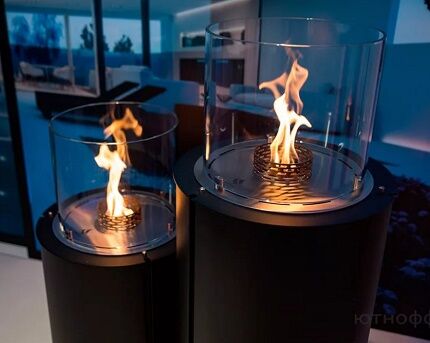

We examined in more detail the principle of operation of a biofuel fireplace in the next article.
Classification by installation method
Such heating devices differ not so much in their design as in their dimensions and location in the apartment. According to the above criteria, three types of eco-fireplaces can be distinguished.
Variety #1 - tabletop
Tabletops are small products that come in a variety of shapes and designs. For fire safety, such structures are provided with a dense fire-resistant glass screen that hides the flame.
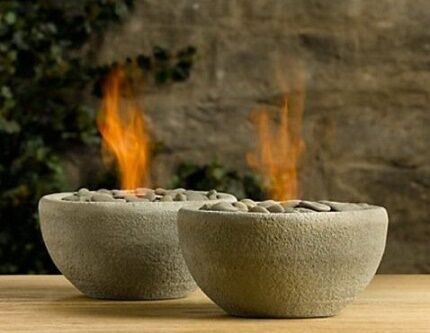
Variety #2 - wall-mounted
Wall-mounted devices, which can be up to 1 meter in length, are usually made of metal and glass. Such models are not only decorative, but also functional. They heat the room, especially if there are several burners installed in the fireplace.
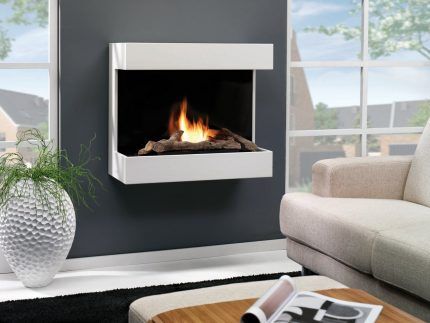
Variety #3 - floor-mounted
Eco-fireplaces, which have large dimensions, are installed on the floor, often in niches or corners of the room. There are floor-standing models, complemented by support legs that allow you to adjust the height of the structure, or wheels, thanks to which the device can be moved around the house.
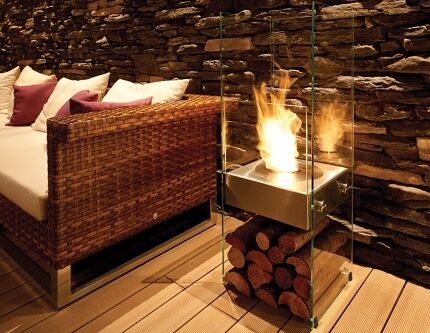
Like wall-mounted biofireplaces, floor-mounted options combine a decorative role with a functional one, filling the room with warmth.
Advantages and disadvantages of biofireplaces
Like any device, such lesions have strengths and weaknesses.
Regardless of the model, all eco-fireplaces have the following advantages:
- Simplicity of the device. Equipping the fireplace does not require laying ventilation ducts, installing a chimney, or agreeing with neighbors.
- Mobility. Biofireplaces are usually quite lightweight devices. Many options are specifically designed for their movement indoors.
- Ease of use. Using such devices is extremely easy. It is only important to purchase on time biofuel and fuel the fireplace.
- Safety. When burning, soot, carbon monoxide, smoke and other harmful substances are not released, and many models have a dense screen that prevents open fire.
- Air humidification. When bioethanol burns, carbon dioxide and water vapor are formed, which improve the indoor microclimate.
At the same time, a number of problems associated with the operation of eco-fireplaces should be noted.
Negative factors include:
- Low heat dissipation. When biofuel burns, a small amount of heat is released.
- High cost of bioethanol. Liquid biofuel is more expensive than traditional fuel options.
- Need for ventilation. Since when a fire burns, the oxygen level in the room where the eco-fireplace is located decreases, it is advisable to arrange additional ventilation in it or take care of frequent ventilation of the room.
The negative aspects of biofoci can be neglected, especially when it comes to decorative devices.
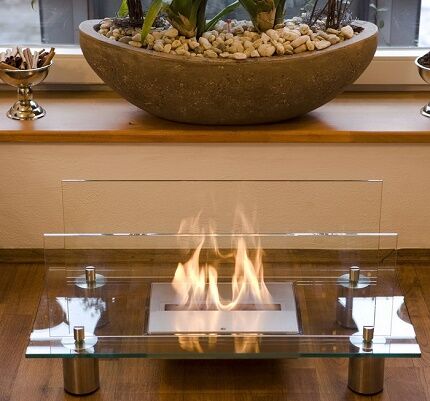
Main design elements
With all the variety of eco-fireplace models, their design consists of similar elements, namely:
- Heating unit. The main component of the biofocus, where the fuel is located. There are two options for such a device: a burner and a tank, which we will discuss below.
- Housings. This detail determines the design of the product. Depending on the project, the body can be open or closed, have the shape of various geometric shapes, or be styled as a shelf, candelabra, or coffee table.
- Decorative components. To decorate eco-fireplaces, decor made from heat-resistant materials is often used: stones, metal, fire-resistant ceramics.
You can make all these parts yourself by building DIY bio fireplace.
Biofireplaces can use two types of heating devices: a fuel tank and a burner.
Fuel tank, the volume of which ranges from 60 ml to 5 liters, is usually used in factory models of biofireplaces.
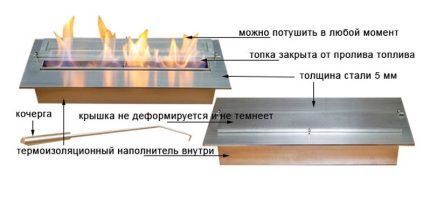
As a rule, tanks are made of durable metal, most often stainless steel. It is very important that the walls and bottom of the device are of sufficient thickness: this guarantees safety and long service life.
Fuel tanks have significant advantages:
- Their design guarantees absolute tightness of the container, so dust and foreign bodies do not get inside.
- When using such models, the smell of bioethanol is completely absent in the room, since liquid fuel and its vapors are retained in the tank.
- The design of fuel tanks provides special devices for regulating the intensity of fire. This is especially important if the fireplace is built into the wall or its surface is decorated with accessories made from materials that are not particularly fire-resistant.
- Such devices also provide the ability to quickly and easily extinguish fire. To do this, just turn the lever, which shuts off the flow of biofuel.
The disadvantage of such models is the rather high price.
A simpler version of the heating unit is burner for eco fireplace. Externally, such a device looks extremely simple: it is a tank designed for pouring bioethanol, which can have different shapes.
Using such devices is not as convenient as a fuel boiler. The burners also do not have a mechanism for regulating the intensity of the fire, as well as the ability to quickly extinguish a flared flame
There are special devices for extinguishing that need to be purchased additionally; in addition, when they are used, a pungent odor is felt in the room.
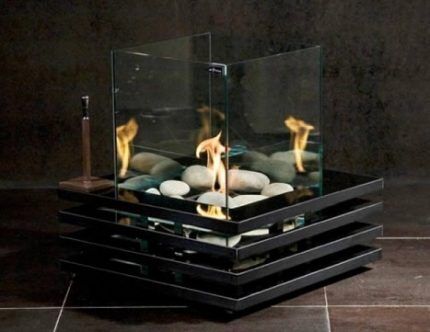
At the same time, biofireplace burners also have their advantages. Such devices are low in price, and their simple design allows you to make them yourself. In addition, several such devices can be installed in one fireplace at once, which will significantly increase heat transfer.
Features of burner manufacturing
Before starting work on creating an eco-fireplace, it is important to decide on the model of the hearth: will it be a large device installed on the floor, a hanging option against the wall, or a compact device that can be placed on the table. The size of the burner directly depends on this.
Once you have decided, try to sketch out a project for a biofireplace in order to prepare drawings of the design and heating element based on it. Since the operating principles of different models are usually the same, design and functionality come to the fore.
It is important to pay great attention to the quality of the materials used, since the safety of the fireplace, as well as the period of its use, depends on this. The heating unit, made from durable materials, will work properly and without failures.
Although biofuel for fireplaces is often packaged in plastic bottles, this does not mean that the burner can be made of plastic: such a device must be made entirely of metal.
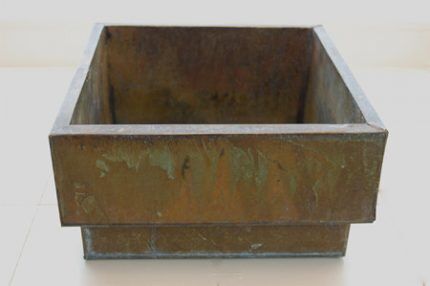
The most durable and reliable devices are made of stainless steel, since this material combines high chemical and thermal resistance. It is also possible to use ordinary structural steel, although its quality indicators are somewhat lower.
For the manufacture of a fuel block, it is important to use blanks with thick walls. Thin parts will deform when heated, which can lead to depressurization of seams and fuel leakage, which can result in a fire.
The size and parameters of the fuel tank depend not only on the dimensions of the model, but also on the design features. If the fuel tank does not require the use of an absorbent, the capacity can be made low. In this case, it is desirable to ensure that only a small surface part of the combustible material is involved in combustion
Biofireplace burners can also be equipped with a glass protective screen. For this purpose, it is better to take fireproof material. If you don’t have it at hand, you can use regular glass, for example, taking it from A4 photo frames. In this case, a greater distance from the burner should be provided so that the material does not burst from overheating.
In order for the flame to be evenly distributed in all directions, it is recommended to cover the top of the fuel tank with a metal mesh. Such a detail will also serve as the basis for strengthening decorative elements.
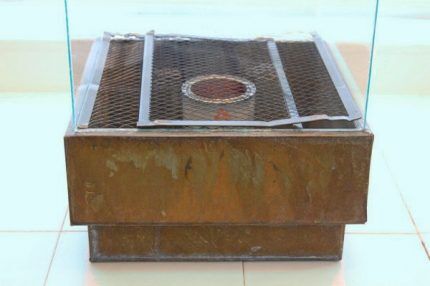
To ignite a homemade burner, a wick is used, which can be made from a shoe lace. One end of it is placed in a tank filled with biofuel, the other is taken out and set on fire. An eco-fireplace has a particularly impressive look, the outer wick of which is hidden between the decorative elements.
The distance from the burner to the glass screen should be approximately 15 cm, the same distance should be maintained between several heating elements if they are installed in one bio-fireplace.
One burner is designed for an area of 16 square meters: this standard should be taken into account when planning a fireplace with several heating devices.
As soon as the bio-fireplace burner is assembled, it is necessary to visually evaluate the structure, check it with the drawing, and also make sure there is no deformation. If defects are detected, the device should be disassembled and the parts carefully refitted.
Burner options for biofireplaces
There are many schemes for making fuel blocks yourself; we offer several simple options.
#1: The simplest fuel cell model
For the simplest version of a biofireplace burner, a regular stainless steel container with walls at least 2 mm thick is used.
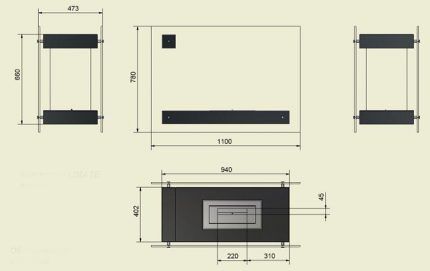
The depth of such a tank should be approximately 3-5 cm, and its length and width should depend on the parameters of the bio-fireplace.The appearance of the tank does not matter, since this part is not in sight, but you should only use a strong, durable design.
It is poured into the tank high-quality biofuel and the wick is lowered, which is brought out to the outer surface, for example, through a mesh thrown over the fire. Once saturated with fuel, the cord will burn when ignited, producing a bright flame.
#2: Double-chamber burner with perforations (slits)
This design option is usually used in models made in factories. It allows you to reduce the combustion surface area, and, consequently, reduce fuel consumption.
First of all, you need to take a bath or other container made of stainless steel, the dimensions and requirements of which are the same as the previous option.
Then you need to cut a plate of the same thickness as the walls of the tank, with a length equal to the length of its internal space.
The width of this element is calculated by the formula:
W = Wв – 1.5 + 2xHв
Where: Wв – width of the internal tank of the bath in cm, and Hv – its depth (also in cm).
The plates are bent at an angle of 90O from the side of the long edges, so as to make legs whose height is equal to the depth of the bath (Hb). In a similar way, we get a U-shaped element, the length of which corresponds to the length of the bath, and the width is 1.5 centimeters less.
We drill holes in one of the legs of the U-shaped part or cut it so that it resembles a comb. The element is installed on legs in the bath so that there is a gap of 1.5 cm between the surface with holes (cuts) and the wall of the tank.
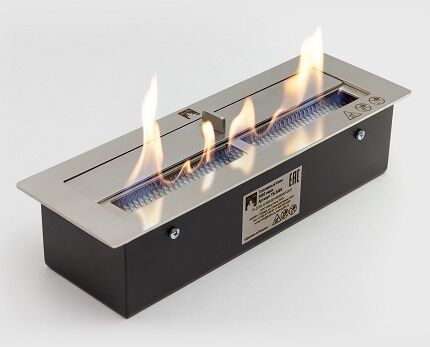
After this, the tank can be filled with fuel and ignited. In this case, a flame will form only on a narrow open strip 1.5 centimeters wide, while the fuel in most of the tank, covered with a U-shaped element, will not burn due to the lack of air access.
At the same time, fuel will constantly flow into the “working” compartment thanks to the slots or holes provided in the plate.
To immediately extinguish the fire, it is also recommended to additionally cut out a steel plate that will cover the combustion zone.
How to make an inclined tank level? In order for the fuel to burn without residue, it is advisable to give the bottom of the model described above a slight slope directed towards the “working” volume.
This is quite easy to do. To do this, you need to pour a certain amount of gypsum mixture into the tank, then tilt it in the desired direction and wait for the solution to harden.
In this case, it is advisable to shorten the “leg” of the U-shaped part, on which there is no perforation, slightly so that the structure remains strictly horizontal, despite the existing slope of the bottom.
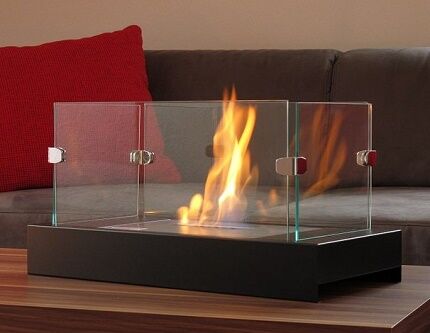
It is also possible to make a fuel tank with a double bottom. To do this, the already manufactured burner is placed in a larger tank, and the edges of the upper element must overlap the walls of the lower one.
#3: The simplest device with filler
The reservoir of the working compartment (U-shaped part) can also be filled with an absorbent (filler), which is most often used mineral wool.
Instead of basalt fibers, it is better to give preference to acrylic-based material for the following reasons:
- This type of glass wool has the highest hygroscopicity, which means it absorbs liquid best.
- The fibrous filler has excellent vapor permeability, therefore, alcohol vapor will circulate freely between the fibers.
- Soft white cotton wool burns for a long time, giving a bright, even flame.
- No formaldehyde is used in the production of this type of mineral wool, which guarantees the environmental purity of the absorbent.
If you were unable to find cotton wool made from acrylic, other types of similar products are suitable, preferably softer materials.
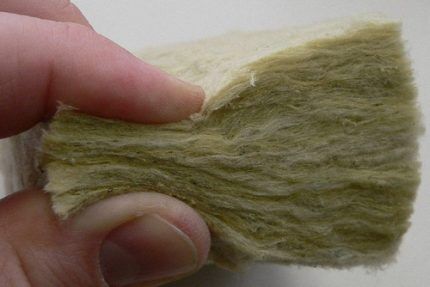
Once saturated with bioethanol, the absorbent will gradually release fuel, prolonging the burning time of the biofireplace.
The lightest version of a burner with a glass wool filler is available to everyone. In this case, a small metal container, such as a mug or tin can, is required. An absorbent is placed in the tank so that it fills the entire volume (there is no need to compact it), after which the filler is well saturated with bioethanol or other liquid fuel.
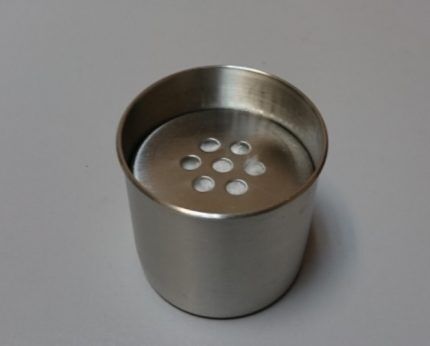
The top of the container is covered with a suitable metal mesh or a lid with perforated holes, after which the fuel is set on fire.
Decorating the fuel device
The fireplace burner can be decorated with additional elements. This will not only improve the design, but will also help disguise the wick.

Among the most popular decorations are:
- Ceramic logs, the size of which must match the dimensions of the fireplace. Such elements will imitate a fire.
- Various types of natural and artificial stones, which can be the same or different sizes, transparent or colored, smooth or with a textured surface. Pebbles can be laid out not only on the grate, but also outside it.
- Stylized surrounding objects: poker, tongs, tools for lighting and extinguishing. Here you can also put fuel in decorative packaging.
Also good are decorative cladding made of heat-resistant ceramics, and clay and faience figurines that can be placed on the fireplace lid or next to it.
It is advisable to use removable decorative components, which will allow you to periodically change the appearance of the device.
Conclusions and useful video on the topic
We offer you instructions for making your own burner for a biofireplace:
Handmade production of a bio-fireplace, an integral part of which is the heating element:
As you can see, the design of the burner is quite easy, and anyone can make it.By placing it in a suitable housing, you will get a wonderful bio-fireplace that will bring comfort and originality to the interior of the room..
Have you thought about making a biofuel fireplace with your own hands? Maybe you have original decorating ideas and want to share them with other users? Or would you like to clarify the technical aspects of the biofireplace assembly process? Or maybe you have already made a stylish fireplace and want to show it to beginners? Write your recommendations and add photos under this article.




A very beautiful and extremely unusual decoration for any interior, but how safe are such fireplaces, especially if the owners got lazy and forgot to turn it off at night, for example? Could the flames be spread to surrounding surfaces by the wind if a window is open in the room where it is installed? And can it, in principle, cause a serious fire?
A biofireplace is the same fire as usual. And his dangers are the same. Yes, a strong gust of wind can cause a small bio-fireplace, especially a homemade one, to topple over. Therefore, you need to buy/make bio-fireplaces with a reliable base and store them away from books and other flammable things.
In principle, the article describes the main disadvantages of bicoamines, but since you are concerned about such important questions regarding safety, I will try to answer them.
First of all, biofireplaces serve more as an aesthetic or design solution to create an ambience or atmosphere in a room.It is unsafe to leave such fireplaces burning unattended, especially at night! The biofuel used in these fireplaces is safe, but drafts or gusts of wind that may occur in the house can spread the fire to nearby areas.
Accordingly, it is not recommended to install such bio-fireplaces near windows - usually a protective structure is built around it to prevent leaks. However, leaving it unattended in working condition is still highly discouraged!
For a home, I think this is a great thing, especially for a country house. Personally, we didn’t bother and bought a fireplace in the store. In general, it’s not that difficult to make, it looks beautiful and doesn’t require much. Design is one of the most important steps in home improvement; everything needs to be done aesthetically and, most importantly, reliably. The principle is simple, but it is important to add fuel from time to time.